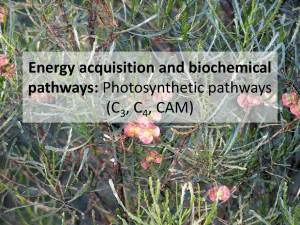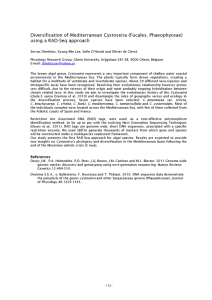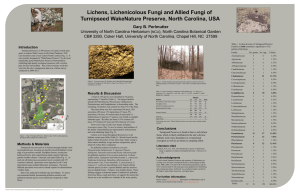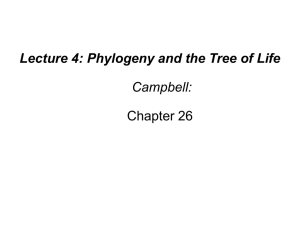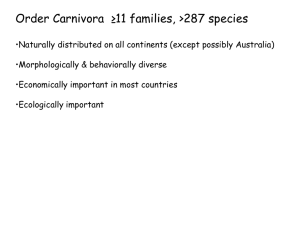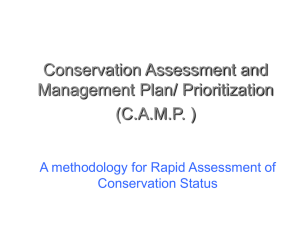BIBI Power Point from 03/23/12
advertisement
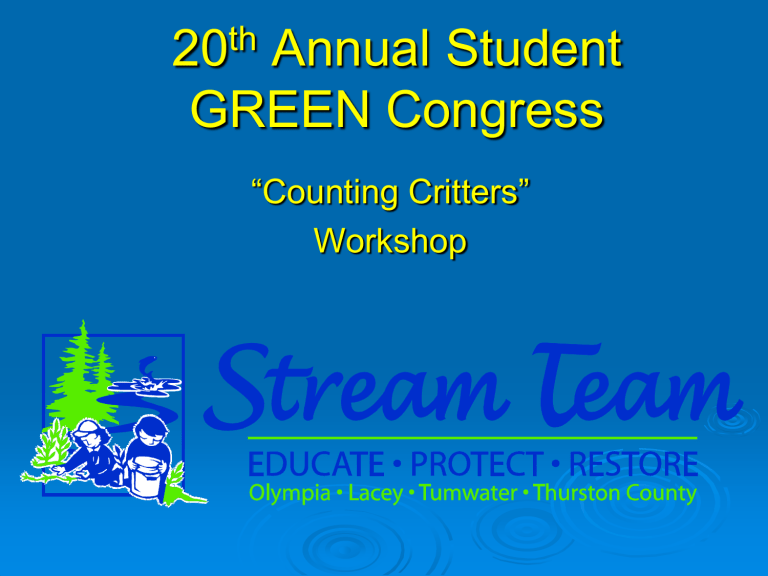
th 20 Annual Student GREEN Congress “Counting Critters” Workshop What are Benthic Macroinvertebrates? Benthic Macro = bottom dwelling = large enough to see with the naked eye Invertebrate = without a backbone (could be a clam, a worm, a crab, or an insect, for example) Often refer to them as “stream bugs” Big Diversity of Benthic Macroinvertebrates Stonefly Leech Black fly larva Mayfly Caddisfly Gilled snail Cranefly Crawdad Midge Dragonfly Mosquito Why Do We Monitor Stream Bugs? Chemical WQ data offers good, but limited information. Only a “snapshot” view of conditions Doesn’t measure “biology” Biological Assessment Use living organisms to tell us something about the environment Why Use “stream bugs” in Bioassessment of Streams Abundant Diverse Sedentary Plus, They Have the Same Habitat Needs as Salmon Clean, cold, oxygenated water Connected migration paths Habitat features for spawning and rearing Dependable stream flows Stream Bugs Tell A Story No “good” or “bad” bugs Presence or absence can be indicators of good or poor stream health. Diversity (not total number of bugs) = Healthier sample How Do They Tell The Story? “Benthic Index of Biological Integrity” B.I.B.I. 10 “metrics” indicating stream health 10 Metrics Mayfly larva Taxa richness # mayfly taxa (Ephemeroptera) # stonefly taxa (Plecoptera) Stonefly # caddisfly taxa (Trichoptera) larva # long-lived taxa # intolerant taxa Caddisfly % tolerant taxa larva % predators # clinger taxa Caddisfly % dominance (3 taxa) case Taxa Richness Stonefly Leech Black fly larva Mayfly Caddisfly Gilled snail Cranefly Crawdad Midge Dragonfly Mosquito % Dominance (3 taxa) Tolerant species Intolerant species bloodworm Ephemeroptera Plecoptera leech Plecoptera netspinner caddisfly Trichoptera Number of Intolerant Taxa lepidostomatidae caddisfly Dobsonfly larva Gilled snail Water penny Riffle beetle ephemerellidae mayfly nymph capniidae stonefly nymph % Tolerant Taxa black fly larva leech Midge larva bloodworm baetidae mayflies netspinner caddisfly Number of Clinger Taxa Water penny Mayfly nymph Stonefly nymph Alderfly Caddisfly larvae – Caddisfly Riffle beetle larva Number of Long-Lived Taxa Pteronarcys stonefly Dragonfly nymph Dragonfly nymph Alderfly larva Gilled snail Number of Mayfly Taxa (Ephemeroptera) Number of Caddisfly Taxa (Trichoptera) Number of Stonefly Taxa (Plecoptera) % Predators taxa Great diving beetle Rhycophila caddisfly Stonefly larva Dragonfly larva water beetle Computing the B.I.B.I. Example: Taxa Richness 0-20 taxa = low (1) 21-40 taxa = moderate (3) 40+ taxa = high (5) Computing the B.I.B.I. Taxa richness # mayfly taxa (Ephemeroptera) # stonefly taxa (Plecoptera) # caddisfly taxa (Trichoptera) # long-lived taxa # intolerant taxa % tolerant taxa % predators # clinger taxa % dominance (3 taxa) 1 1 1 1 1 1 1 1 1 1 3 3 3 3 3 3 3 3 3 3 5 5 5 5 5 5 5 5 5 5 Computing the B.I.B.I. Taxa richness 3 # mayfly taxa (Ephemeroptera) 5 # stonefly taxa (Plecoptera) 3 # caddisfly taxa (Trichoptera) 1 # long-lived taxa 1 # intolerant taxa 3 % tolerant taxa 1 % predators 3 # clinger taxa 5 % dominance (3 taxa) 5 TOTAL: 30 Final B.I.B.I. Scores* Caddisfly 10 – 16 = Very Poor 18 - 26 = Poor 28 – 36 = Fair 38 – 44 = Good 46 - 50 = Excellent Stonefly *10 Metric B-IBI Score used by Mindy Allen When in the Field…. Observe: land use, canopy cover…etc.

